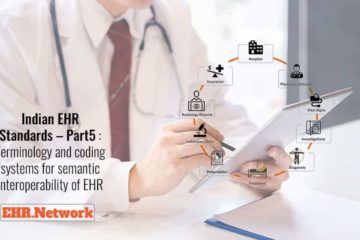Indian EHR Standards – Part4 : Semantic interoperability of EHR via shared clinical models

Achieving semantic interoperability of EHR is an underlying theme of the Indian EHR standards. In this edition of our series of Indian Electronic Health Records standards, we will analyze this aspect in more detail. In particular, this post looks at the role of curated, open & shared clinical information models.
One of the major purpose that healthcare information systems should serve is the optimum delivery of healthcare services and treatment programs. Since healthcare is not just a temporary event or happening but a perpetual affair that covers the entire lifespan of a person, the need to bring in semantic interoperability for healthcare information systems becomes paramount.
Syntactic vs semantic interoperability of EHR
Interoperability of data in IT systems majorly works on two levels – syntactic and semantic. Syntactic interoperability is transactional and is defined at the interface layer. Often we add this is added as an afterthought to exchange information between independently designed systems. As opposed to this, we aim for semantic interoperability at the design stage of software to ensures a more meaningful data exchange that includes both information and the context of the information. Our EHR system should not just do the former, but we should design them to deliver the latter
The Ministry of Health and Family Welfare(MOHFW) has taken a staged approach to enhance large scale adoption of the EHR technology and provide optimum security of health information.They are doing this through initiatives such as implementing specifications, encouraging transparency and ensuring semantically interoperable EHR for Indian citizens. The Indian EHR standards includes pointers, such as openEHR, to the direction that the country is projected to move.
Data first design that creates systems that support personalized care
Since there are many clinical systems already in place, the first phase in pushing for EHR adoption is to define an exchange format and convert the proprietary data into that format as needed. Here the focus is on the applications and interface design, with no thought given to the underlying data. In the second phase, developers are encouraged to standardize models for health data first and build new EHR systems on top. This will eliminate interoperability issues completely and achieve semantic information exchange through system design.
As the pace of EHR adoption picks up, most healthcare organizations are beginning to realize that their data is more valuable than their applications. Since good data is key to improving outcomes, managing chronic disease and enabling population health management, it is becoming the key asset in their armory of tools. We need to manage this key asset for the lifetime of the person, while we all know that EHR applications are not going to last that long. The question all of them are asking is ‘what happens to health data when we switch applications?’
Solution to the above problem is to turn the focus from applications to data. Imagine if the proposed National Health Stack for India builds on it’s common resources to include shared clinical information models that cover varied aspects of healthcare. That would create the right environment to support an Integrative healthcare paradigm. Imagine if instead of building applications, the government were to standardize models for health data?
Modelling for the lowest common denominator
While it is unrealistic to expect that any application could cover the diverse requirements of healthcare, it would be possible to define a common set of clinical information models to support several different solutions. This would provide different stakeholders with choice of applications and vendors while at the same time delivering on the goal of including semantic interoperability of EHR in system design. It would also prevent vendor lock-in by making healthcare applications easier to interoperate and replace, while eliminating the high costs of data migration.
We have designed our EHR.Network platform with this philosophy of shared clinical information models. It has been designed in line with the openEHR Reference Model and is designed to work with any openEHR Archetypes & Templates. Applications built on EHR.Network will remain future proof, portable and interoperable. We already incorporate a large number of clinical models from the International community governed Clinical Knowledge Manager(CKM). Apart from the cloud hosted public platform, we offer EHR.Network for collaboration and co-creation to build modern healthcare applications. Please contact us to know more.
More about the EHR Platform
- Pricing
- Product presentation
- Documentation
- Developer resources, postman collections etc.
- Request more details









0 Comments